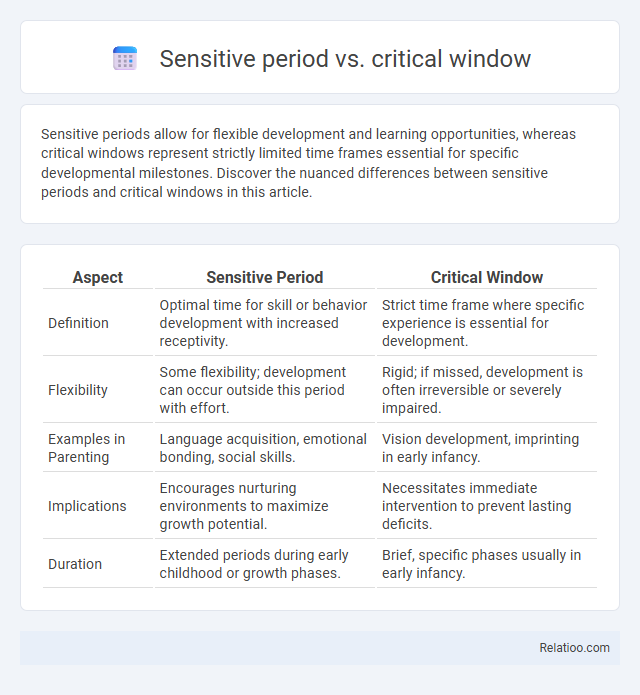Sensitive periods allow for flexible development and learning opportunities, whereas critical windows represent strictly limited time frames essential for specific developmental milestones. Discover the nuanced differences between sensitive periods and critical windows in this article.
Table of Comparison
| Aspect | Sensitive Period | Critical Window |
|---|---|---|
| Definition | Optimal time for skill or behavior development with increased receptivity. | Strict time frame where specific experience is essential for development. |
| Flexibility | Some flexibility; development can occur outside this period with effort. | Rigid; if missed, development is often irreversible or severely impaired. |
| Examples in Parenting | Language acquisition, emotional bonding, social skills. | Vision development, imprinting in early infancy. |
| Implications | Encourages nurturing environments to maximize growth potential. | Necessitates immediate intervention to prevent lasting deficits. |
| Duration | Extended periods during early childhood or growth phases. | Brief, specific phases usually in early infancy. |
Defining Sensitive Period and Critical Window
A sensitive period refers to a developmental phase during which the brain is particularly receptive to specific environmental stimuli, allowing for optimal learning and adaptation, while a critical window denotes a strict timeframe when certain experiences must occur for normal development to proceed; missing this window can result in irreversible deficits. Sensitive periods are more flexible and extend over longer durations, enabling some capacity for catch-up learning, whereas critical windows are narrow and rigid, with little chance for recovery if missed. Understanding these distinctions informs strategies in education, neurorehabilitation, and behavioral interventions to harness brain plasticity effectively.
Key Differences Between Sensitive Periods and Critical Windows
Sensitive periods refer to developmental phases when the brain is especially receptive to specific environmental stimuli, allowing for optimal skill acquisition and learning, whereas critical windows denote strict time frames beyond which certain abilities cannot develop properly. Sensitive periods are flexible and allow some plasticity, enabling skills acquisition outside these intervals with reduced efficiency, in contrast to critical windows that enforce irreversible effects if missed. The key difference lies in the permanence of missed opportunities: sensitive periods involve heightened sensitivity without absolute deadlines, while critical windows impose rigid, irreversible developmental constraints.
Neurobiological Foundations
Neurobiological foundations distinguish sensitive periods as developmental phases when the brain exhibits heightened plasticity, allowing Your experiences to significantly shape neural circuits. Critical windows refer to specific, limited timeframes during which particular stimuli must occur for normal development, often involving irreversible neural changes. Sensitive periods differ by offering flexibility, with brain adaptations possible beyond these times, emphasizing the importance of timing and environmental input in neurodevelopment.
Examples in Human Development
Critical windows, such as the development of vision in infants, represent precise time frames where specific sensory experiences must occur to ensure normal function. Sensitive periods, like language acquisition in early childhood, are extended phases during which the brain is especially receptive to particular stimuli but retain some plasticity beyond this time. For instance, imprinting in birds exemplifies a critical window, while learning musical skills in adolescence illustrates a sensitive period in human development.
Impact on Language Acquisition
Critical windows represent narrow, biologically predetermined phases crucial for language acquisition, where deprivation leads to irreversible deficits. Sensitive periods span broader timeframes, offering increased neuroplasticity that facilitates easier language learning but still allows for successful acquisition later on. Your ability to learn and master a language efficiently is heavily influenced by these sensitive periods, making early and immersive exposure essential for optimal linguistic development.
Role in Sensory and Motor Development
Sensitive periods represent phases when the brain is particularly receptive to specific sensory and motor experiences, allowing for optimized development and plasticity. Critical windows are narrower, defined intervals during which certain sensory or motor functions must develop, or irreversible deficits may occur if stimuli are absent. Understanding these periods is essential for interventions in sensory processing disorders and motor skill acquisition, emphasizing timely exposure to appropriate stimuli for effective neurodevelopment.
Educational Implications
Sensitive periods refer to optimal times for learning specific skills when the brain is most receptive, while critical windows denote narrow, often irreversible phases essential for developing fundamental abilities like vision or language. Understanding these distinctions informs educators to tailor interventions that harness sensitive periods for skill acquisition, while ensuring essential experiences occur within critical windows to prevent deficits. Emphasizing timing in curriculum design and early childhood education maximizes cognitive development and supports long-term academic success.
Consequences of Missing a Critical Window
Missing a critical window during early development can lead to irreversible deficits in sensory, cognitive, or emotional functions due to the brain's diminished plasticity after this period. Sensitive periods allow for some degree of learning and recovery beyond the optimal timeframe, but critical windows represent narrow, non-negotiable phases essential for foundational neural circuit formation. The consequences of missing a critical window often include permanent impairments, such as language delays or vision problems, which are less likely to improve significantly later in life.
Recent Research and Debates
Recent research distinguishes the sensitive period as a flexible timeframe for optimal learning, unlike the rigid critical window which denotes an irreversible phase for specific development. Debates focus on whether sensitive periods can be extended or reopened through environmental enrichment or neuroplasticity interventions. Understanding these nuances helps you tailor educational and therapeutic approaches to maximize developmental outcomes.
Implications for Parenting and Intervention
Critical windows represent specific developmental stages where environmental inputs are essential for proper neural and behavioral outcomes, making early intervention crucial to avoid irreversible deficits. Sensitive periods refer to broader timeframes when the brain exhibits heightened plasticity, allowing for more flexible and effective parenting strategies that support skill acquisition and emotional growth. Understanding these distinctions guides caregivers to tailor interventions with optimal timing, enhancing cognitive, social, and emotional development in children.

Infographic: Sensitive period vs Critical window
 relatioo.com
relatioo.com